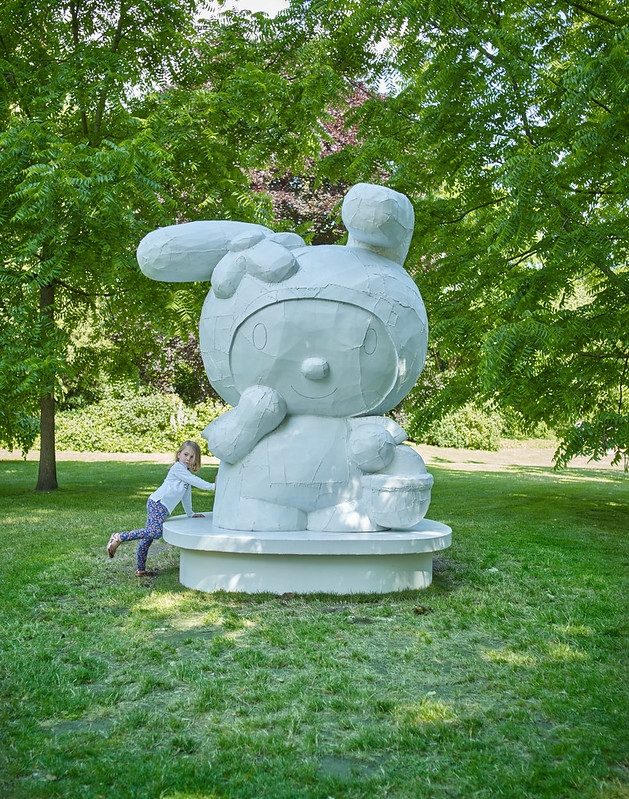Readers may remember that, this time last year, ArtReview’s correspondent attended the opening of Frieze Sculpture’s 2018 edition, describing it in terms which were often impolite, frequently derisory and, at times, bordered on hate-speech. For some reason, that correspondent wasn’t invited to the opening of the 2019 edition. Maybe there’s no connection. Maybe there is. What do I know? Either way, it falls to this writer to head for the press view of open-air contemporary sculpture, installed (for the summer by Frieze Art Fair, ahead of the fair’s London editions opening in October) in the more genteel, manicured part of Regent’s Park known as The English Gardens.
London is enjoying a heatwave. I arrive and am faced by a giant My Melody (2008), by Tom Sachs. Readers young enough to remember the 1980s will know that My Melody is a rabbit in a red bonnet, one of the lesser associates of Hello Kitty, from Japan’s Sanrio brand family of cute characters. But rather than a cute My Melody, this My Melody is vaguely monstrous and ghostly, a patchwork of welded scraps, painted a dull, putty-white. Not cute at all, more a My Melody of an 80s childhood nightmare, where, one imagines, this inflated avatar might be found lumbering around, Akira-like, bleeding black goo from its poorly welded seams.

Snapping out of it, I realise that none of the tourists nearby care what I think and are all happily selfie-ing in front of Sachs’s sculpture. Sculptures, don’t forget, are nowadays only selfies-in-waiting. Moving along with the press group, led by Frieze Sculpture’s guest curator Clare Lilley (director of programmes at Yorkshire Sculpture Park), it bothers me that half these sculptures seem to be small things scaled up, as if the artists had got their hands on a sci-fi growth-raygun and started zapping this and that. There’s a scaled-up E-type Jaguar (Mnemonic Vehicle No. 2, 2015) courtesy of Vik Muniz, which is to say that it’s the same size as a lifesize E-type Jaguar, only that’s it’s what a Matchbox toy car version of an E-Type would look like if you scaled it up. Which it does; a perplexing lo-resolution inflation of a thing you might have once held in your hand as a child. There’s a scaled-up cog mechanism, Superhero Cog Woman #01 (2019), by LR Vandy, which vaguely resembles a figure in a skirt, a ‘tribute to women throughout time, the unmentioned drivers of industry’, according to the Frieze app guide. And there’s a scaled-up blackbird’s egg, The Hatchling (2019), by Joanna Rajkowska. Frieze Sculpture looks, then, as if a gigantic child had strolled through the anyway somewhat miniaturised aesthetic of the English Gardens, inattentively dropping giant-sized Kinder Egg toys here and there as they went.

This is of course unfair to those works which don’t fall into the trap of presenting sculpture as a 3D version of an image to be grammed. Tracey Emin’s large bronze When I Sleep (2018) bucks this trend – a prone half-human, half-animal figure, all exposed back and long, foal-like legs, provokes emotional recognition and misrecognition, impossible to grasp from any angle, raw and dreaming, and better for it. Tai-Jung Um’s A Stranger Holding Two Wings (2018) continues a long, internationalised conversation of abstract sculpture – two vertical aluminium slabs held upright by a slanting black armature – suggesting tension and interdependence that makes emotional as well as architectonic sense. But it’s a stand-off between these more subtle works that care about sculptural ideas – like the slipperiness of visual reference, or the position one looks at a thing from, or the sense of presence of a material – and those works that deliver their message like a jpeg. A senior member of the Frieze Art Fair team abruptly sweeps away from the press group to tell some kids to stop climbing on the Vik Muniz while their parents snap them on their smartphones, then anxiously instructs a Frieze-uniformed guard to keep an eye that it doesn’t happen again. I hear Lilley explain, slightly apologetically, that these sculptures are all very expensive. Behind the whole scene looms Robert Indiana’s circle of huge Corten numerals, ONE Through ZERO (1980–2002), which riffs on Pop and Minimalism, and now, decades later, seems prophetic of the spectacular culture sculpture has now been absorbed into.
It’s 5pm and, just like last year, the little picket-fence enclosure is there, with the champagne and the flock of summer-dressed guests. My immediate concern is to find someone with a lighter, which proves to be so difficult I wonder whether smoking is banned in the English Gardens. In reality, it’s just that the beautiful people of the artworld have all quit. “It’s bad for you,” one of the bouncers at the entrance tells me wryly, while offering me his lighter. I think something about the difference between matter and images, about the slightly dirty physicality of smoking and the purely visual pleasure of fine suits and elegant dresses, and then leave.
Online exclusive published on 10 July 2019
